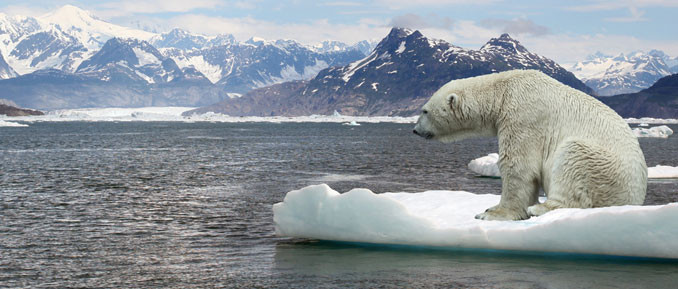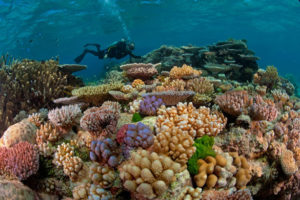
The impact of climate change may be one of the greatest threats facing all life on Earth today. Around the world, rising temperatures and extreme weather patterns are already affecting the habitats of many plants and animals. Undoubtedly, their fate will depend on their ability to either migrate away from or adapt to the new environment, and eventually evolve as a species.
But, can life on our planet adapt in time? Most researchers believe that the rate in which our climate is changing now may be too rapid for many species to keep up. Scientific evidence is showing that increasingly warmer temperatures over the past century have already resulted in marked ecological changes, including deviations in growing seasons, species ranges, and patterns of seasonal breeding. 1
Notably, this warming trend is taking a toll on wildlife across the globe. From polar bears and penguins in the arctic, to Asian elephants, and coral off the Great Barrier Reef, numerous species are now in danger of extinction. 2 Human health is also at risk, even though it’s probable that our way of life is accelerating global warming. 3

Scientists that study climate change and its effects on organisms are concerned that Earth may be on the verge of another mass extinction, similar to what happened to the dinosaurs. 4 They want to know if adaptation in response to climate change is occurring, and if it will be beneficial in the long run. One hot topic in science that is showing some exciting results in the area of adaptation and temperature is epigenetics.
Epigenetics looks at how the environment and other external factors affect genes and their behavior. Environmental conditions, like heat and toxins, affect DNA indirectly by modifying certain epigenetic factors or mechanisms. These mechanisms produce compounds that attach to the DNA and interact with the genetic material, yet do not alter the underlying DNA code. Rather, they instruct the genes whether or not to be expressed. Epigenetic modifications can pass from cell to cell, and under some circumstances, can persist into the next generation. This allows for variation within a species to increase at a faster pace, making adaptation possible under severe environmental stressors.
Featured here are some interesting studies that have investigated epigenetic modifications in different species and how they may have been affected by climate change.
Winter Skate
As the earth warms, so does its oceans and other water bodies. Warmer waters have less dissolved oxygen which is needed for aquatic plants and animals to survive. Each species oxygen requirement is different depending on how large or complex it is. So, when water temperatures increase, fish, plants and other organisms are at risk of dying of asphyxiation unless they can seek new areas, or adapt quickly.

A group of scientists studying winter skate (Leucoraja ocellata) from the southern Gulf of St. Lawrence (sGSL) found that the fish were able to adapt to the area’s warmer waters by dramatically decreasing their body size. The study, which investigated the transcriptome of two different populations of winter skate, found that the sGSL fish achieved this by epigenetically modifying their genes to make a physiological change. The smaller size permits them to withstand the lower oxygen concentrations in the 10°C warmer water.
The researchers determined that the sGSL species didn’t technically evolve, as their DNA was identical to the control skate group. Rather, they adapted to the warmer water temperature by altering their gene expression patterns. In total, the scientists observed 3,653 changes in gene expression, including changes in DNA methylation that they believe may have enabled this species to biologically adjust to the novel environment. Whereas evolution occurs very slowly over several generations, epigenetic changes can sometimes take place within one generation. Although this skate underwent the adaptation process over 7,000 years, on an evolutionary scale this is fast given its life span. Since the genetic code was not changed, it also suggests that epigenetic modifications can persist over several generations. The results from this study indicate that certain species may be better suited to deal with present changes in climate and have been for some time. 5
Guinea Pigs
All parts of an ecosystem are impacted with climate change, including animals that live on land. In particular, mammals that require a specific type of environment, such as extreme cold or high humidity, may be more vulnerable to variations in their surroundings. It is believed that most mammals will unfortunately not be able to adjust to an altered climate. Their ability to hide, eat, drink, and breed, in many cases, will be greatly disrupted. Given that most mammals have a relatively short lifespan (less than 20 years), their adverse response to any unsuitable climate will likely take place in a short time period. 6 That is, unless they can change in a way that allows them to survive and reproduce in the new environment.
One small mammal is proving that adaptation to a change in climate may be possible by fine-tuning its DNA, or at least the chemical structures attached to its DNA. Studying the wild guinea pig (Cavia aperea) males in an artificially controlled environment, German researchers reported on epigenetic changes seen in the rodent as a response to changes in temperature. These epigenetic changes altered the activity of certain genes and some were then passed down to future offspring.

Like other mammals, wild guinea pigs must compensate for fluctuations in external temperatures to maintain their own internal body heat. To study the guinea pigs’ epigenetic response to heat, the researchers looked at the animal’s liver, the main metabolic heat producing area of the body. They also analyzed the germ cells in the testes of the newborn offspring to determine if the epigenetic response was possibly transmitted to the subsequent generation. Comparing the subjects before and after heat treatment, the researchers identified shared changes in DNA methylation patterns within and across generations, as well as in different organs.
It is believe that these epigenetic changes may only be temporary to the guinea pig, as they were not observed in future generations. The researchers theorize that the ability for a species like the wild guinea pig to “epigenetically adapt” may be significantly important for survival as global temperatures continue to rise. 7
Forest Trees
Not all species can flee the effects of climate change. As global temperatures rise, many plants and animals will gradually move north and to higher altitudes where temperatures are cooler in order to stay within their ideal range of environmental conditions. However, some species will not be able to relocate fast enough. For example, certain trees with long life cycles and/or slow dispersion, or those that inhabit isolated areas, are particularly at risk. 8 They may die out faster unless they can adapt in time to withstand the new climate.
Scientists have been studying epigenetic effects on plants for some time, in particular how epigenetics might help develop crops that can withstand extreme weather effects like droughts. They are also interested in how forest trees — critical in mitigating climate change — respond to drastic temperature changes from season to season, and if this phenomenon involves epigenetic modifications.

Researchers studying spruce trees in Norway have found evidence that epigenetic mechanisms acting on certain genes may contribute to their ability to endure drastic temperature variations. When temperatures are extremely low, as in 200°C below zero, the trees become hardened to tolerate the cold. Yet in the spring, when the trees begin to bud, they are nearly intolerant to the freezing temperatures and could die if confronted with a late frost. This study, which has followed the clonal trees for eight years so far, determined that the trees have an internal thermostat — one that is set by epigenetic mechanisms when the tree is still a seed. How they respond each season is biologically preprogrammed in them, like an epigenetic memory.
The data collected indicated that epigenetic marks are established on the spruce’s DNA during the embryo seed development stage in response to the temperatures being experienced. They also found that the majority of the differently expressed genes were related to DNA and histone methylation, as well as sRNA pathway, putative thermosensing, and signaling genes. These genes, they believe, might be responsible for formulating the epigenetic memory in the spruce embryos. While the research team will continue to monitor the trees for several more years, they are hopeful that their findings will contribute more to our understanding of the molecular mechanisms involved in epigenetic memory which is critical for the survival of the spruce tree. Moreover, the study demonstrates that these trees, and perhaps other plants, may be more adaptable to climate change than previously expected. 9
Epigenetics for conservation efforts
Understanding epigenetics may or may not help a species survive climate change. However, what we are learning now from this field could assist in conservation efforts. For instance, studies that identify which species can cope and which are vulnerable to environmental changes could prove invaluable for preserving our current ecosystems. In addition, epigenetic studies on genes involved in adaptation and temperature might aid in selective breeding or improve upon genetic engineering approaches. Right now, we are only just beginning to understand epigenetics, especially in regard to adaptation. More research on this topic is needed. In the meantime, supporting climate change initiatives might help and hopefully lessen the extinction threats now facing many of our more vulnerable species.

